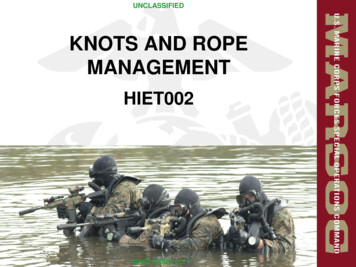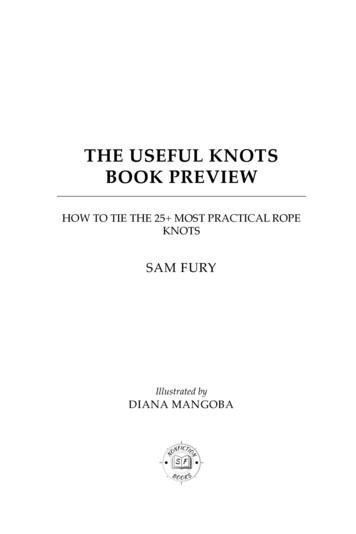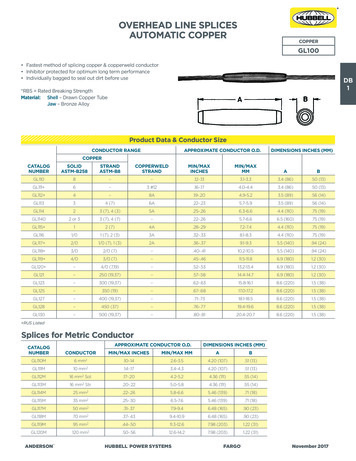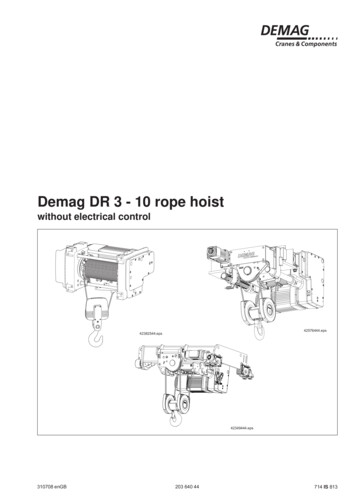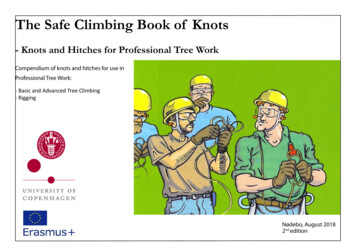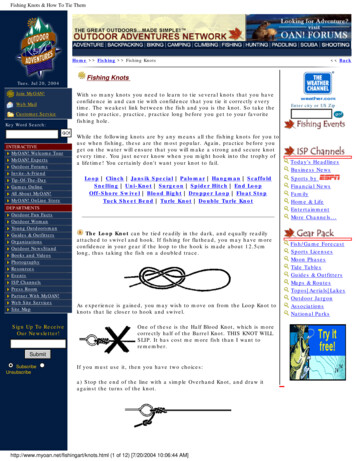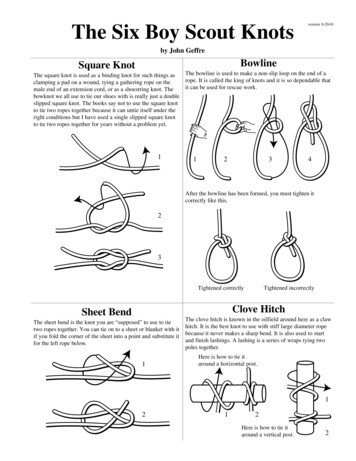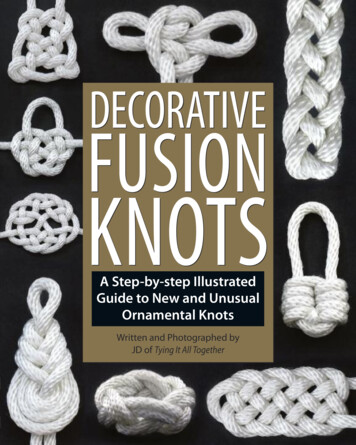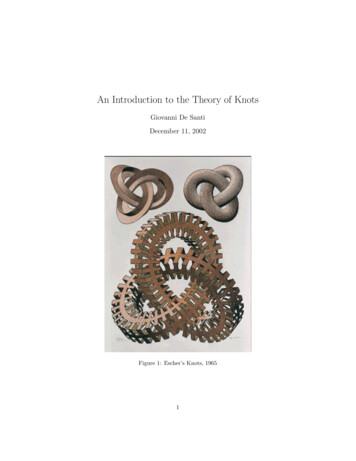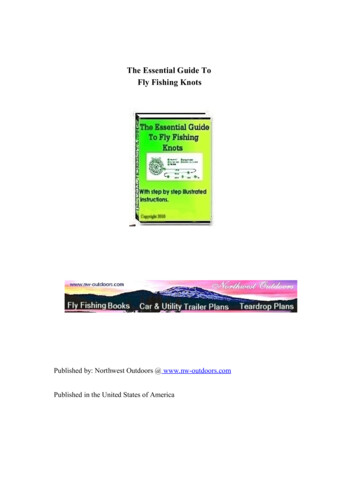
Transcription
Digital book created and publish*VICTORIA INSTITUTIONSDeverkovil 673508 UTIONTelegram HomePage: https://t.me/VI Home/8Books by VED from VICTORIA INSTITUTIONS
NEXT PAGEPREVIOUS PAGEFIRST PAGEGO BACKWARDSSEARCHCONTENTS PAGEKNOTS, SPLICES and ROPEWORKA PRACTICAL TREATISEGiving Complete and Simple Directions for Making All the Most Useful and OrnamentalKnots in Common Use, with Chapters on Splicing, Pointing, Seizing, Serving, etc. Adaptedfor the Use of Travellers, Campers, Yachtsmen, Boy Scouts, and All Others Having to Useor Handle Ropes for Any Purpose.ByA. HYATT VERRILLEditor Popular Science Dept., "American Boy Magazine."SECOND REVISED EDITIONIllustrated with 156 Original Cuts Showing HowEach Knot, Tie or Splice is Formed and ItsAppearance When Complete.Books by VED from VICTORIA INSTITUTIONS
NEXT PAGEPREVIOUS PAGEFIRST PAGEGO BACKWARDSSEARCHCONTENTS PAGECONTENTSINTRODUCTIONCHAPTER 1CORDAGEJKinds of Rope. Construction of Rope. Strength of Ropes. Weight of Ropes. Material Usedin Making Ropes.CHAPTER IISIMPLE KNOTS AND BENDSParts of Rope. Whipping and Seizing Rope. Loops. Cuckolds' Necks. Clinches. Overhandand Figure-eight Knots. Square and Reef Knots. Granny Knots. Open-hand and Fisher men's Knots. Ordinary Knots and Weavers' Knots. Garrick Bends and Hawser Hitches.Half-hitches.CHAPTER IIITIES AND HITCHESLarks' Heads. Slippery and Half-hitches. Clove Hitches. Gunners' Knots and TimberHitches. Twists, Catspaws, and Blackwall Hitches. Chain Hitch. Rolling and MagnusHitches. Studding-sail and Gaff-topsail Halyard Bends. Roband and Fisherman's Hitches.CHAPTER IVNOOSES, LOOPS, AND MOORING KNOTSWaterman's Knot. Larks' Heads with Nooses. Cleat and Wharf Ties. Bow-line Knots.Loops and Loop Knots.CHAPTER VSHORTENINGS, GROMMETS, AND SELVAGEESTwo-, Three-, and Fivefold Shortenings. Single Plaits and Monkey Chain. Twist Braidsand Braiding Leather. Open Chains. Seized and Bow Shortenings. Sheepshanks andDogshanks. Grommets. Selvagee Straps and Selvagee Boards. Flemish and ArtificialEyes. Throat Seizings. Lashed Splices.CHAPTER VILASHINGS, SEIZINGS, SPLICES, ETC.Wedding Knots and Rose Lashings. Deadeye and Loop Lashings. Belaying-pin Splice.Necklace Ties. Close Bands and End Pointing. Ending Ropes. Short Splices. Long Splices.Eye and Cut Splices.CHAPTER VIIFANCY KNOTS AND ROPE WORKSingle Crown Knots. Tucked Crowns. Single Wall Knots. Common and French ShroudKnots. Double Crown and Double Wall Knots. Crowning Wall Knots. Double Wall andCrown. Manrope Knots. Topsail-halyard Toggles. Matthew Walker and Stopper Knots.Turks' Pleads and Turks' Caps. Worming, Parcelling, and Serving. Serving Mallet. Half hitch Work. Four-strand and Crown Braids. Rope Buckles and Swivels. Slinging Casksand Barrels. Rope Belting.INDEXBooks by VED from VICTORIA INSTITUTIONS
NEXT PAGEPREVIOUS PAGEFIRST PAGEGO BACKWARDSSEARCHCONTENTS PAGEINTRODUCTIONThe history of ropes and knots is so dim and ancient that really little is known of theirorigin. That earliest man used cordage of some kind and by his ingenuity succeeded intying the material together, is indisputable, for the most ancient carvings and decora tions of prehistoric man show knots in several forms. Doubtless the trailing vines andplants first suggested ropes to human beings; and it is quite probable that these samevines, in their various twistings and twinings, gave man his first idea of knots.Since the earliest times knots have been everywhere interwoven with human affairs;jugglers have used them in their tricks; they have become almost a part of many occu pations and trades, while in song and story they have become the symbol of steadfast ness and strength.Few realize the importance that knots and cordage have played in the world's history,but if it had not been for these simple and every-day things, which as a rule are givenfar too little consideration, the human race could never have developed beyond sav ages. Indeed, I am not sure but it would be safe to state that the real difference betweencivilized and savage man consists largely in the knowledge of knots and rope work. Nocloth could be woven, no net or seine knitted, no bow strung and no craft sailed on lakeor sea without numerous knots and proper lines or ropes; and Columbus himself wouldhave been far more handicapped without knots than without a compass.History abounds with mention of knots, and in the eighth book of "Odyssey" Ulysses isrepresented as securing various articles of raiment by a rope fastened in a "knotclosed with Circean art"; and as further proof of the prominence the ancients gave toknots the famous Gordian Knot may be mentioned. Probably no one will ever learn justhow this fabulous knot was tied, and like many modern knots it was doubtless fareasier for Alexander to cut it than to untie it.The old sorcerers used knots in various ways, and the witches of Lapland sold sailorsso-called "Wind Knots," which were untied by the sailors when they desired a particu lar wind. Even modern conjurors and wizards use knots extensively in their exhibi tions and upon the accuracy and manner in which their knots are tied depends thesuccess of their tricks.In heraldry many knots have been used as symbols and badges and many old Coats ofArms bear intricate and handsome knots, or entwined ropes, emblazoned upon them.As to the utility of knots and rope work there can be no question. A little knowledge ofknots has saved many a life in storm and wreck, and if every one knew how to quicklyand securely tie a knot there would be far fewer casualties in hotel and similar fires. Ina thousand ways and times a knowledge of rope and knots is useful and many timesnecessary. Many an accident has occurred through a knot or splice being improperlyformed, and even in tying an ordinary bundle or "roping" a trunk or box few people tiea knot that is secure and yet readily undone and quickly made. In a life of travel andadventure in out-of-the-way places, in yachting or boating, in hunting or fishing, andeven in motoring, to command a number of good knots and splices is to make life safer,easier, and more enjoyable, aside from the real pleasure one may find in learning theinteresting art of knot-tying.Through countless ages the various forms of knots and fastenings for rope, cable, orcord have been developed; the best kinds being steadily improved and handed downfrom generation to generation, while the poor or inferior fastenings have been dis carded by those whose callings required the use of cordage.Gradually, too, each profession or trade has adopted the knots best suited to its re quirements, and thus we find the Sailor's Knot; the Weaver's Knot; Fishermen's knots;Builders' knots; Butchers' knots; and many others which have taken their names fromthe use to which they are especially adapted.In addition to these useful knots, there are many kinds of ornamental or fancy knotsused in ornamenting the ends of ropes, decorating shrouds of vessels, railings, andsimilar objects; while certain braids or plaits, formed by a series of knots, are widelyBooks by VED from VICTORIA INSTITUTIONS
NEXT PAGEPREVIOUS PAGEFIRST PAGEGO BACKWARDSSEARCHCONTENTS PAGEused aboard ship and on land.In many cases ropes or cable must be joined in such a way that they present a smoothand even surface and for such purposes splices are used, while knots used merely astemporary fastenings and which must be readily and quickly tied and untied are com monly known as "bends" or "hitches." Oddly enough, it is far easier to tie a poor knotthan a good one, and in ninety-nine cases out of a hundred the tyro, when attempting tojoin two ropes together, will tie either a "slippery" or a "jamming" knot and will sel dom succeed in making a recognized and "ship-shape" knot of any sort.The number of knots, ties, bends, hitches, splices, and shortenings in use is almostunlimited and they are most confusing and bewildering to the uninitiated. The mostuseful and ornamental, as well as the most reliable, are comparatively few in number,and in reality each knot learned leads readily to another; in the following pages I haveendeavored to describe them in such a manner that their construction may be readilyunderstood and mastered.THE AUTHOR.JANUARY, 1917.Books by VED from VICTORIA INSTITUTIONS
NEXT PAGEPREVIOUS PAGEFIRST PAGEGO BACKWARDSSEARCHCONTENTS PAGECHAPTER ICORDAGEBefore taking up the matter of knots and splices in detail it may be well to give atten tion to cordage in general. Cordage, in its broadest sense, includes all forms and kindsof rope, string, twine, cable, etc., formed ofbraided or twisted strands.In making a rope or line the fibres (A, Fig. 1) ofhemp, jute, cotton, or other material areloosely twisted together to form what is tech nically known as a "yarn" (B, Fig. 1). Whentwo or more yarns are twisted together theyform a "strand" (C, Fig. 1). Three or morestrands form a rope (D, Fig. 1), and three ropesform a cable (E, Fig. 1). To form a strand theyarns are twisted together in the opposite di rection from that in which the original fibresFig. i.—Construction of rope.were twisted; to form a rope the strands aretwisted in the opposite direction from theyarns of the strands, and to form a cable each rope is twisted opposite from the twistof the strands. In this way the natural tendency for each yarn, strand, or rope tountwist serves to bind or hold the whole firmly together (Fig. 1).Rope is usually three-stranded and the strands turn from left to right or "with the sun,"while cable is left-handed or twisted "against the sun" (E, Fig. 1). Certain ropes, suchas "bolt-rope" and most cables, are laid around a "core" (F, Fig. 2) or central strandand in many cases are four-stranded (Fig. 2).The strength of a rope depends largely upon the strength and length of the fibres fromwhich it is made, but the amount each yarn and strand is twisted, as well as the methodused in bleaching or preparing the fibres, has much to do with the strength of thefinished line.Roughly, the strength of ropes may be calculated by multiplying the cir cumference of the rope in inches by itself and the fifth part of the productwill be the number of tons the rope will sustain. For example, if the ropeis 5 inches in circumference, 5 X 5 25, one-fifth of which is 5, the numberof tons that can safely be carried on a 5-inch rope. To ascertain theweight of ordinary "right hand" rope, multiply the circumference in inchesby itself and multiply, the result by the length of rope in fathoms anddivide the product by 3.75. For example, to find the weight of a 5-inchrope, 50 fathoms in length: 5 X 5 25; 25 x 50 1,250; 1,250 -h 3.75 3331/3 lbs. These figures apply to Manila or hemp rope, which is the kindcommonly used, but jute, sisal-flax, grass, and silk are also used consid erably. Cotton rope is seldom used save for small hand-lines, clothes lines, twine, etc., while wire rope is largely used nowadays for riggingvessels, derricks, winches, etc., but as splicing wire rope is differentfrom the method employed in fibre rope, and as knots have no place inwire rigging, we will not consider it.Books by VED from VICTORIA INSTITUTIONSFig. 2.—Bolt-rope.
NEXT PAGEPREVIOUS PAGEFIRST PAGESEARCHGO BACKWARDSCONTENTS PAGECHAPTER IISIMPLE KNOTS AND BENDSFor convenience in handling rope andlearning the various knots, ties, andbends, we use the terms "standingpart," "bight," and "end" (Fig. 3). TheStanding Part is the principal portionor longest part of the rope; the Bight isthe part curved or bent while working /?dor handling; while the End is that partFig. 3.—Parts of rope.used in forming the knot or hitch. Be fore commencing work the loose endsor strands of a rope should be "whipped" or "seized" to prevent the rope from unravel ling; and although an expert can readily tie almost any knot, make a splice, or in factdo pretty nearly anything with a loose-ended rope, yet it isa wise plan to invariably whip the end of every rope, cable,or hawser to be handled, while a marline-spike, fid, orpointed stick will also prove of great help in working rope.To whip or seize a rope-end, take a piece of twine or stringand lay it on the rope an inchor two from the end, passthe twine several timesaround the rope, keeping theends of the twine under theFig. 4.—Whipping,first few turns to hold it inplace; then make a largeloop with the free end of twine; bring it back to the ropeand continue winding for three or four turns aroundboth rope and end of twine; and thenfinish by drawing the loop tight bypulling on the free end (Fig. 4).Fig. 5.—Cuckolds’ necks.All knots are begun by "loops" orrings commonly known to mariners as "Cuckolds' Necks" (Fig. 5).These may be either overhand or underhand, and when a seizing orfastening of twine is placed around the two parts where they crossa useful rope ring known as a "clinch" is formed (Fig. 6).Fig. 7Figs. 7Fig. 8and 8.—Overhand knots.If the loose end of therope is passed over theFig. 6.—Clinchstanding part and throughthe "cuckold's-neck," the simplest of all knots,known as the "Overhand Knot," is made (Fig.7). This drawn tight appears as in Fig. 8, andwhile so simple this knot is important, as it isfrequently used in fastening the ends of yarnsand strands in splicing, whipping, and seiz ing.The "Figure-Eight Knot" is al most as simple as the over hand and is plainly shown inFigs. 9 and 10.Fia.9Fio. 10Figs. 9 and 10.—Figure-eight knots.Books by VED from VICTORIA INSTITUTIONS
NEXT PAGEPREVIOUS PAGEFIRST PAGEFig.iiSEARCHGO BACKWARDSFig. 12Figs, ii and 12.—Square knots.Only a step beyond the figure-eight and the overhand knots are the "Square" and"Reefing" knots (Figs. 11 and 12). The square knot is probably the most useful andwidely used of any common knot and is the best all-around knot known. It is verystrong, never slips or becomes jammed, and is readily untied. To make a square knot,take the ends of the rope and pass the left end over andunder the right end, thentheright over and under the left.If you once learn the simple formula of"Left over," "Right over," you will nevermake a mistake and form the despised"Granny," a most useless,bothersome, and deceptivemakeshift for any purpose(Fig. 13). The true "Reef Knot"is merely the square knotwith the bight of the left orright end used instead of theFig. 13.—Granny knot.end itself. This enables theknot to be "cast off" morereadily than the regular square knot (A, Fig. 12).Fig. 14.—Slipped square knot.Neither square nor reef knots, however, are reliable when tying two ropesof unequal size together, for under such conditions they will frequently slip and ap pear as in Fig. 14, and sooner or later will pull apart.To prevent this the ends may be tied or seized as shown in Fig. 15.A better way to join two ropes of unequal diameter is to use the "Open-handKnot." This knot is shown in Fig. 16, and is very quickly and easily made; itnever slips or gives, but is rather large and clumsy, and if too great a strain isput on the rope it is more likely to break at the knot than at any other spot.The "Fisherman's Knot," shownin Fig. 17, is a good knot and isformed by two simple overhandknots slipped over each rope,and when drawn taut appearsas in Fig. 18.Fig. 17.—Fisherman’s knot (making).Fig. 18—Fisherman’s knot (finished).Fig. 16.—Open-hand knots.This is an important and valuable knotfor anglers, as the two lines may bedrawn apart by taking hold of the ends,A, B, and a third line for a sinker, or ex tra hook, may be inserted between them.In joining gut lines the knot should beleft slightly open and the space betweenwrapped with silk. This is probably thestrongest known method of fasteningfine lines.F,G- ‘5' Squ”e knot 'vilh ends Ki“d-Books by VED from VICTORIA INSTITUTIONS
NEXT PAGEPREVIOUS PAGEFIRST PAGEGO BACKWARDSSEARCHCONTENTS PAGEThe "Ordinary Knot," for fastening heavy ropes,is shown in Fig. 19.Fig. 19.—Ordinaryknot (finished).It is made by forming a simple knot andthen interlacing the other rope or "fol lowing around," as shown in Fig. 20. Thisknot is very strong, will not slip, is easyto make, and does not strain the fibres ofthe rope. Moreover, ropes joined with this knot wiFig. 20.—Ordinary knot (tying).pay out, or hang, in a straight line.By whipping the ends to the standing parts itfor rope, and for thread it is without doubtthe best knot known.in Fig. 24. This is a variation of the figure-eightknot, already described, and is used where thereis too much rope, or where a simple knot is de sired to prevent the rope runningthrough an eye, ring, or tackle-block.Fig. 22.—Weaver’s knot (complete).Fig24.—Double figure-eight knot (complete),It is made by forming a regular figureeight and then "following round" withthe other rope as in Fig. 25. It is thendrawn taut and the ends seized to thestanding part if desired.Fig. 25.—Double figure-eight knot (tying).Books by VED from VICTORIA INSTITUTIONS
NEXT PAGEPREVIOUS PAGEFIRST PAGEGO BACKWARDSSEARCHCONTENTS PAGEIG. 26.—Garrick bend (finished).Sometimes we have occasion to join two heavyor stiff ropes or hawsers, and for this purposethe "Garrick Bend" (Fig. 26) is preeminently thebest of all knots. To make this knot, form a bightby laying the end of a rope on top of and acrossthe standing part.Next take the end of the other rope and pass itthrough this bight, first down, then up, overthe cross and down through the bight again,so that it comes out on the opposite side fromthe other end, thus bringing one end on topand the other below, as illustrated in Fig. 27.If the lines are very stiff or heavy the knotmay be secured by seizing the ends to thestanding parts.Fig. 27.—Garrick bend (tying)A much simpler and a far poorer knotis sometimes used in fastening twoheavy ropes together. This is a simplehitch within a loop, as illustrated inFig. 28.—Simple hitch (hawser).Fig. 28, but while it has the advantageof being quickly and easily tied it is soinferior to the Garrick bend that I advise al to adopt the latter in its place.Fig. 29.—Half-hitch and seizing.When two heavy lines are to be fastened for any considerable time, a good method isto use the "Half-hitch and Seizing," shown in Fig. 29. This is a secure and easy methodof fastening ropes together and it allows the rope to be handled more easily, and topass around a winch or to be coiled much more readily, than when other knots areused.Books by VED from VICTORIA INSTITUTIONS
NEXT PAGEPREVIOUS PAGEFIRST PAGEGO BACKWARDSSEARCHCONTENTS PAGECHAPTER IIITIES AND HITCHESAll the knots I have so far described are used mainly for fastening the twoends of a rope, or of two ropes, together. Of quite a different class are theknots used in making a rope fast to a stationary or solid object, and areknown as "hitches" or "ties."One of the easiest of this class to make and one which is veryuseful in fastening a boat or other object where it may be nec essary to release it quickly is the "Lark's Head" (Fig. 30). Tomake this tie, pass a bight of your rope through the ring, orother object, to which you are making fast and then pass amarline-spike, a billet of wood, or any similar object throughthe sides of the bight and under or behind the standing part, asshown in A, Fig. 30.Fig. 30.—Lark’s head withtoggle (A).The end of the rope may then be laid over and under the standing partand back over itself. This knot may be instantly released by merelypulling out the toggle.Almost as quickly made and unfastened is the "Slippery Hitch" (Fig.32).Fig. 31.—Lark’s head withtoggle (A) withdrawn.Fiti. 31. Lark's head wkhtoggle {A) withdrawn.To make this, run the end of the rope through the ring or eye to whichit is being fastened, then back over the standing part and pull a loop,or bight, back through the "cuckold's neck" thus formed (Fig. 33). Tountie, merely pull on the free end.Fig. 32.—Slippery hitch(complete).Fig. 33 —Slippery hitch(tying).Two half-hitches, either around a post or timber or around the standing part ofthe rope, make an ideal and quickly tied fastening (Figs. 34 and 35). To make these,pass the end around the post, ring, or other object, then over and around the standingpart between the post and itself, then under and around the standing part and betweenits own loop and the first one formed. After a little practice you can tie this knot almostinstantly and by merely throwing a couple of turns around a post, two half-hitchesmay be formed instantly. This knot will hold forever without loosening, and even on asmooth, round stick or spar it will stand an enormous strain without slipping.Fig. 36B.—Clove hitch (complete).A more secure knot for this same purpose is the "Clove Hitch" (Fig. 36), sometimesknown as the "Builders' Hitch."To make this, pass the end of rope around the spar or timber, then over itself; over andaround the spar, and pass the end under itself and between rope and spar, as shown inthe illustration.Fig. 56 A.—Clove hitch or builder’s hitch (tying).Books by VED from VICTORIA INSTITUTIONS
NEXT PAGEPREVIOUS PAGEFIRST PAGEGO BACKWARDSSEARCHCONTENTS PAGEThe Clove hitch with ends knotted becomesthe "Gunners' Knot" (Fig. 37). These areamong the most valuable and important ofknots and are useful in a thousand and oneplaces. The Clove hitch will hold fast on asmooth timber and is used extensively bybuilders for fastening the stageing to theupright posts. It is also useful in making atow-line fast to a wet spar, or timber, andeven on a slimy and slippery spile it willseldom slip.Fig.37.—Gunner’s knot.Forthis purpose the "Timber Hitch" (Fig. 38)is even betterthan the Clove hitch. It is eas ily made by passing the end of a rope around the spar or log, round the standing partof the rope and then twist it three or more times around, under and overitself.Fig. 38.—Timber hitch.If you wish this still more secure, a single half-hitch may be taken withthe line a couple of feet further along the spar (Fig. 39).It is remarkable what power to grip a twisted rope has, and the "TwistKnots" shown in Figs. 40 and 41 illustrate two ways of making fast whichare really not knots at all but merely twists.Fig.39.—Timber hitch and half-hitch.These may be finished by a simple knot, or a bow-knot, as shown in Fig.42, but they are likely to jam under great pressure and are mainly useful intying packages, or bundles, with small cord, where the line must be held tautuntil the knot is completed.This principle of fastening by twisted ropeis also utilized in the "Catspaw" (Fig. 43),a most useful knot or "hitch" for hoistingwith a hook.Figs. 40 and 41.—“Twists.’To make this, pass the bight of your ropeoverthe end and standing part, then, witha bight in each hand, take three twists from you,then bring the two bights side by side and throwover the hook (Fig. 44).The "Blackwall Hitch" (Fig. 45) is still simpler andeasier to make and merely consists of a loop, orcuckold's neck, with the end of rope passed under neath the standing part and across the hook so thatas soon as pressure is exerted the standing partbears on the end and jams it against the hook.Fig. 43.—Catspaw.Fig. 44.—Catspaw (tying).Fig.The "Chain Hitch" (Fig. 46) is avery strong method of fasten ing a line to a timber, or largerope, where one has a rope ofsufficient length, and is usedfrequently to help haul in alarge rope or for similar purposes.It consists simply of a number of half hitches taken at intervals around the ob ject and is sometimes used with a lever orhandspike, as shown in Fig. 47.Fin.—Chain hifrh with har.J7.Books by VED from VICTORIA INSTITUTIONS45.—Blackwali hitch.
NEXT PAGEPREVIOUS PAGEFIRST PAGEGO BACKWARDSSEARCHCONTENTS PAGEThe "Rolling Hitch" is a modified Clove hitch and is shown inFig. 48.The "Magnus Hitch" (Fig. 49) is a method frequently used onshipboard for holding spars;Fig. 48.—Rolling hitch.and the "Studding-sail Bend" (Fig. 50) is also used for this pur-Fig. 49.—Magnus hitch,pose.Fig. 50.—Studding-sail bend.FlO. 51 A.—Roband hilch(front).Fig. 51 I).—Roband hitch(back).Occasions sometimes arise where a tackle, hook, ring, or another rope must be fas tened to a beam by the same rope being used, and in such cases the "Roband Hitch"(Fig. 51) comes in very handy.These are all so simple and easily understood from the figures that no explanation isnecessary.Almost as simple are the "Midshipman's Hitch" (Fig. 52), the "Fish erman's Hitch" (Fig. 53), and the "Gaff Topsail Halyard Bend" (Fig.54). The midshipman's hitch is made by taking a half-hitch aroundthe standing part and a round turn twice around above it.Fig. 53.—Fisherman's hitch.The fisherman's hitch is particularly useful in making fast largehawsers; with the end of a rope take two turns around a spar, orthrough a ring; take a half-hitch around the standing part and un der all the turns; then a half-hitchround the standing part only and ifdesired seize the end to standingpart.The gaff-topsail bend is formed bypassing two turns around the yardand coming up on a third turn overboth the first two turns; over its ownpart and one turn; then stickthe endunder the first turn.Fig. 54.—GafT-topsail halyard bend.Books by VED from VICTORIA INSTITUTIONSFig. 52.—Midshipman’s hitch.
NEXT PAGEPREVIOUS PAGEFIRST PAGEGO BACKWARDSSEARCHCONTENTS PAGECHAPTER IVNOOSES, LOOPS AND MOORING KNOTSNothing is more interesting to a landsman than the mannerin which a sailor handles huge, dripping hawsers or cablesand with a few deft turns makes then fast to a pier-head orspile, in such a way that the ship's winches, warping the hugestructure to or from the dock, do not cause the slightest giveor slip to the rope and yet, a moment later, with a few quickmotions, the line is cast off, tightened up anew, or paid out asrequired.Fie.Clove hitches, used as illustrated in Fig. 55, and known asthe "Waterman's Knot," are often used, with a man holdingthe free end, for in this way a slight pull holds the knot fast,55.—Waterman’s knot.while a little slack gives the knot a chance to slip withoutgiving way entirely and without exerting any appreciable pull on the man holding theend."Larks' Heads" are also used in conjunction with a running noose, as shown in Fig. 56,while a few turns under and over and around a cleat, or about two spiles,is a method easily understood and universally used by sailors (Fig. 57).The sailor's knot par excellence, however, is the "Bow-line" (Fig. 58), andwherever we find sailors, or seamen, we will find thisknot in one or another of its various forms. When youcan readily and surely tie this knot every time, you mayfeel yourself on the road to "Marline-spike Seamanship,"for it is a true sailor's knot and never slips, jams, orfails; is easily and quickly untied, and is useful in a hun dred places around boats or in fact in any walk of life.The knot in its various stages is wellshown in Fig. 59 and by following theseillustrations you will understand itmuch betterthan by a description alone.In A the rope is shown with a bight or cuckold's neckformed with the end over the standing part. Pass A backthrough the bight, under, then over, then under, as shownin B, then over and down through the bight, as shown in Cand D, and draw taut, as in E.The "Bow-line on a Bight" (Fig 60) is just as easily madeand is very useful in slinging casks or barrels and informing a seat for men to be lowered over cliffs, or build ings, or to be hoisted aloft aboard ship for painting, cleaning, orrigging.A "Running Bow-line" (Fig. 61) is merely a bow-line with the endpassed through the loop, thus forming a slip knot.Other "Loops" are made as shown in Figs. 62-65, but none of theseand useful as the Fig. 60.—Bow-line on bight.are as safe, sure,bow-line.Books by VED from VICTORIA INSTITUTIONS
NEXT PAGEPREVIOUS PAGEFIRST PAGEGO BACKWARDSSEARCHCONTENTS PAGEOne of these knots, known as the "Tomfool Knot" (Fig. 66), is used as handcuffs and hasbecome quite famous, owing to its having baffled a number of "Flandcuff Kings" andother performers who readily escaped from common knots and manacles. It is madelike the running knot (Fig. 62), and the firm end is then passed through the open, simpleknot so as to form a double loop or bow. If the hands or wrists are placed within theseloops and the latter drawn taut, and the loose ends tied firmly around the central part,a pair of wonderfully secure handcuffs results.Books by VED from VICTORIA INSTITUTIONS
NEXT PAGEPREVIOUS PAGEFIRST PAGEGO BACKWARDSSEARCHCONTENTS PAGECHAPTER VSHORTENINGS, GROMMETS, AND SELVAGEESIn many cases a rope may prove too long for our use or the free endsmay be awkward, or in the way. At such times a knowledge of"shortenings" is valuable. There are quite a variety of these usefulknots, nearly all of which are rather handsome and ornamental, infact a number of them are in constant use aboard ship merely forornament.Fig. 67.—Twofold shortening(making).The simplest form of shortening, shown in Fig. 67, is avariation of the common and simple overhand knot al ready described and illustrated.These knots are formed by passing the end of a rope twiceor more times through the loop of the simple knot and thendrawing it tight (Fig. 68). They are known as "Double," "Tre ble," "Fourfold," or "Sixfold" knots and are used to prevent a rope from pass ing through a ring or block as well as for shorten ing.Fig. 68.—Twofold short ening (taut).All gradations from the double to the sixfold areshown in Fig. 69, both in process of making and asthey appear when drawn taut.Another very simple form of shortening is shown in Fig.70 and is known as the "Single Plait," or "Chain Knot." Tomake this shortening, make a running loop (A, Fig. 70),then draw a bight of the rope through this loop, as shown at B, draw another bightthrough this, as at C to D, and continue in this way until the rope is shortened tothe desired length; the free end should then be fastened by passing a bit of stickthrough the last loop, F, or by running the free end through the l
and securely tie a knot there would be far fewer casualties in hotel and similar fires. In a thousand ways and times a knowledge of rope and knots is useful and many times necessary. Many an accident has occurred through a knot or splice being improperly formed, and even in tying an
